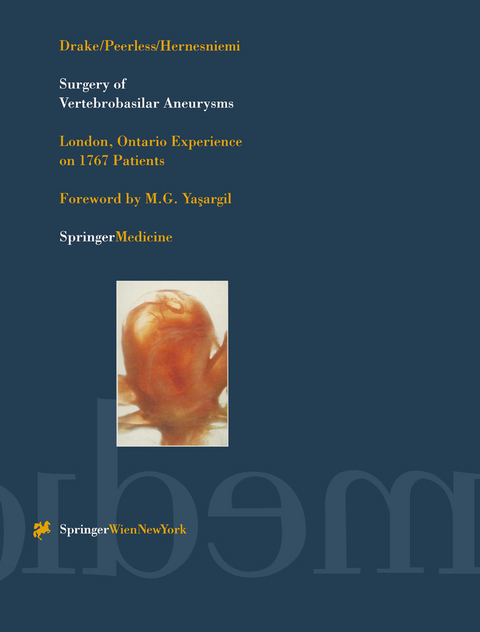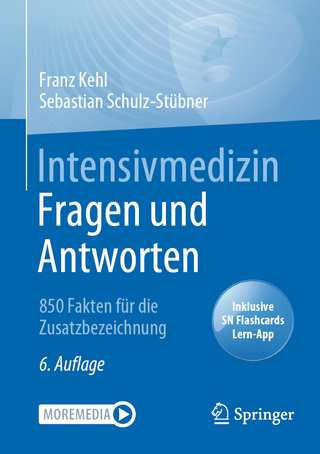
Surgery of Vertebrobasilar Aneurysms
Springer Wien (Verlag)
978-3-7091-9411-9 (ISBN)
1. Historical Notes.- 2. Clinical Material.- 3. Small Aneurysms at the Bifurcation of the Basilar Artery: 493 Patients.- Clinical Features.- Early Surgical Experience.- Anatomical Features.- The Subtemporal Approach.- Induced Intraoperative Hypotension.- The Transsylvian (Pterional) Approach.- Other Approaches.- Upward Projecting Basilar Bifurcation Aneurysms.- High Basilar Bifurcation.- Low Basilar Bifurcations.- Forward Projecting Aneurysms.- Backward Projecting Aneurysms.- Results.- 4. Large (or Bulbous) Basilar Bifurcation Aneurysms (12.5-25 mm): 265 Patients.- Clinical Features.- Results.- 5. Analysis of Operative Morbidity in Basilar Bifurcation Aneurysms: Small and Large (Non-Giant): 758 Patients.- Perforator Injury or Occlusion.- Final Comments on Non-Giant Basilar Bifurcation Aneurysms.- 6. Giant Basilar Artery Bifurcation Aneurysms: 137 Cases.- Anatomical Features of Giant Basilar Bifurcation Aneurysms.- Clinical Features.- Treatment.- Explored Only.- Intra-Aneurysmal Occlusion.- Neck Clipping.- Vertebral Artery Occlusion.- Basilar Artery Occlusion.- 7. Non-Giant (Small and Large) Basilar Superior Cerebellar Artery Aneurysms: 210 Patients.- Anatomical Features.- Clinical Features.- Treatment.- 8. Giant Basilar-Superior Cerebellar Artery Aneurysms: 56 Patients.- Anatomical Features.- Clinical Features.- Explored Only.- Neck Clipping.- Basilar Artery Occlusion.- 9. Midbasilar Trunk Aneurysms: 44 Patients.- Anatomical Features.- Clinical Features.- Approach.- Results.- 10. Basilar-Anterior Inferior Cerebellar Artery Aneurysms: 41 Patients.- Anatomical Features.- Clinical Features.- Approaches.- Results.- 11. Giant Basilar Trunk Aneurysms: 59 Patients.- Anatomical Features.- Clinical Features.- Treatment.- Neck Clipping.- Parent Artery Occlusion.- Trapping.- 12.Vertebral-Basilar Junction Aneurysms: 77 Patients.- Anatomical Features.- Clinical Features.- Approach.- Results.- 13. Giant Vertebrobasilar Junction Aneurysms: 39 Patients.- Treatment.- Vertebral Artery Occlusion.- Trapping and Evacuation.- 14. Non-Giant Aneurysms of the Vertebral Artery: 181 Patients.- Anatomical Features.- Classification.- Clinical Features.- Approaches.- Results.- 15. Giant Vertebral Aneurysms: 40 Patients.- Anatomical Features.- Clinical Features.- Treatment.- 16. Non-Giant Aneurysms of the Posterior Cerebral Artery: 59 Patients.- Anatomical Features.- Clinical Features.- Subtemporal Approach.- Results.- 17. Giant Posterior Cerebral Aneurysms: 66 Patients.- Anatomical Features.- Clinical Features.- Treatment.- 18. Multiple Aneurysms: 462 Patients.- Treatment.- 19. Vertebrobasilar Aneurysms and Associated AVMs: 54 Patients.- General Principles of Treatment.- Patients.- Treatment.- Summary of Poor Results.- 20. Solitary Incidental Vertebrobasilar Aneurysms: 70 Patients.- 21. Vertebrobasilar Artery Aneurysms in Children: 49 Patients.- Clinical Features.- Treatment.- 22. Timing of Surgery.- Rebleeding: Transfer of Patients.- Early versus Late Surgery.- Final Comments on Timing of Surgery.- 23. The Anesthetic Management of Patients During Posterior Fossa Aneurysm Surgery.- Preoperative Preparation.- Premedication.- Anesthesia Management.- Monitoring.- Induction.- Maintenance.- Fluid Administration.- Induced Hypotension, Temporary Arterial Occlusion, and Cerebral Protection.- Emergence and Recovery.- Positioning.- Monitoring of Brain Stem Function.- Complications.- Conclusion.- 24. Endovascular Saccular Treatment of Posterior Circulation Aneurysms.- Detachable Balloons.- Thrombosis with Coiled Wires.- Experience at the University of Western Ontario, 1971 to 1994.- Conclusions.- 25. Complications of Surgery for Vertebrobasilar Artery Aneurysms and Final Comments.- Factors Increasing Complication Rates.- Influence of Surgical Timing.- Complications During Anesthesia.- Problems in Exposure.- Intraoperative Aneurysm Rupture.- Perforator Injury.- Inadvertent Major Vessel Occlusion.- Postoperative Deterioration of Neurological State.- Memory Deficits.- Postoperative Hematoma.- Incomplete Occlusion and Re-Operation (Failed Aneurysm Surgery).- Vasospasm.- Rebleeding.- Postoperative Infection.- Medical Complications.- Hydrocephalus.- Statistical Analysis for Predictors of Poor Outcome.- Discussion.- Final Comments.- References.
| Erscheint lt. Verlag | 19.1.2012 |
|---|---|
| Vorwort | M.G. Yasargil |
| Zusatzinfo | XX, 329 p. |
| Verlagsort | Vienna |
| Sprache | englisch |
| Maße | 210 x 279 mm |
| Gewicht | 867 g |
| Themenwelt | Medizinische Fachgebiete ► Chirurgie ► Neurochirurgie |
| Medizin / Pharmazie ► Medizinische Fachgebiete ► Neurologie | |
| Medizinische Fachgebiete ► Radiologie / Bildgebende Verfahren ► Radiologie | |
| Schlagworte | anatomy • anesthesia • Aneurysm • brain • Circulation • classification • Hydrocephalus • Neuroradiology • Neuroscience • neurosurgery • Radiology • Surgery • Surgical technique |
| ISBN-10 | 3-7091-9411-3 / 3709194113 |
| ISBN-13 | 978-3-7091-9411-9 / 9783709194119 |
| Zustand | Neuware |
| Informationen gemäß Produktsicherheitsverordnung (GPSR) | |
| Haben Sie eine Frage zum Produkt? |
aus dem Bereich


